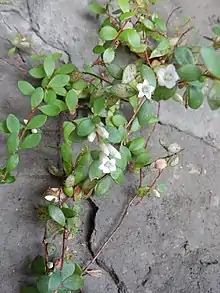Epacris crassifolia
Epacris crassifolia is a plant in the heath family Ericaceae which is endemic to central eastern New South Wales, Australia. There are two varieties of E. crassifolia: var. crassifolia and var. macroflora. A small spreading plant found in sandstone ledges and crevices. Leaves are dark green in colour; stiff, thick and shiny with a rounded tip. 5 to 13 mm long, 1.7 to 5 mm wide. This is one of the many plants first published by Robert Brown with the type known as "(J.) v.v." It appears in his Prodromus Florae Novae Hollandiae et Insulae Van Diemen in 1810.[1][2]
| Epacris crassifolia | |
|---|---|
 | |
| Epacris crassifolia growing on Hawkesbury sandstone at Garigal National Park. | |
| Scientific classification | |
| Kingdom: | Plantae |
| Clade: | Tracheophytes |
| Clade: | Angiosperms |
| Clade: | Eudicots |
| Clade: | Asterids |
| Order: | Ericales |
| Family: | Ericaceae |
| Genus: | Epacris |
| Species: | E. crassifolia |
| Binomial name | |
| Epacris crassifolia | |
References
- Les Robinson - Field Guide to the Native Plants of Sydney, ISBN 978-0-7318-1211-0 page 106
- J. M. Powell. "Epacris crassifolia R.Br". Plantnet - New South Wales Flora Online. Royal Botanic Gardens, Sydney. Retrieved 30 October 2021.
This article is issued from Wikipedia. The text is licensed under Creative Commons - Attribution - Sharealike. Additional terms may apply for the media files.